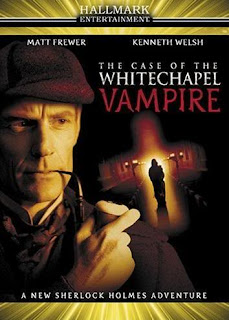Directed by: Rodney Gibbons
Release date: 2002
Contains spoilers
This is Sherlock Holmes second screen adapted case involving a vampire, as far as I am aware, and alongside The Last Vampyre we reach the sum total of on screen confrontation between Holmes and the undead… or is it, for like the earlier made for TV adaptation we are asked to wonder whether it is a vampire or not.
Of course, a human killer masquerading as a vampire still allows a film to be within the vampire genre and in this case I will reveal, as the film takes great pains to make us wonder but never maintains the masquerade, that the foe is human. I won’t reveal who, however.
The first shots of the film sees a man leading a donkey drawn cart through the streets of London, until he passes by a chapel in Whitechapel. It has to be said that some of the scenery in this is quite lovely and you do get the impression of Victoriana England. The screenshot here shows the cross outside the chapel and I felt it to be wonderfully gothic.
In the chapel a monk, Brother Sinclair (Norris Domingue), goes to pray, he seems nervous. A cloaked figure appears behind him and in a sinister whisper says, “Brother you have sinned”. We hear the monk scream. We have our first glimpse of the vampire and, until the end, we see no more than a shadowy, hooded figure.
Sherlock Holmes (Matt Frewer – yes, Max Headroom himself) and Doctor Watson (Kenneth Walsh) discuss spiritualism. Holmes is a sceptic and clearly atheist (though later he describes himself as agnostic). Mrs Hudson (Kathleen McAuliffe) brings Holmes a note from Brother Marstoke (Shawn Lawrence) asking for Holmes help. It was here that I was struck by my first issue with the production – the accents, especially that affected by Frewer. A nasal, faux-British upper class effort that made it sound as though I was in a bad interpretation of Jeeves and Wooster – I lived with it, but only just.
The chapel housed a mixed order of monks and nuns, some of whom had been on missionary duty together in South America. Marstoke has a series of idols from their time abroad, including one of a demonic vampire deity named Desmodo. It seems that there was an outbreak of rabies around the vicinity of their mission. Fearing that vampire bats were spreading the disease the order tried to poison the bats, following which two of the order were killed by the cloaked figure. They returned to England but the killing had stopped whilst Marstoke travelled for a year, it began again when he returned. The murderer has a habit of writing cryptic threats on the walls near his attack, in blood.
It is clear that the monks and nuns believe that a devil in the form of a vampire is at work, as do the common folk of Whitechapel, but Holmes believes it to be a human assailant. Police suspicion falls to a bat specialist, Dr Chargas (Neville Edwards), but it is unsubtly hinted that suspicion towards him is because of the colour of his skin.
Vampire wise there are some nods towards the genre. Chargas has lodgings on Renfield Place, which was a fairly subtle little reference as no great play was made upon it. In order to make us believe that it might be a real vampire, during a failed attack on a blind nun called Sister Helen (Cary Lawrence), the good sister holds up a crucifix and the vampire backs away momentarily – but then immediately ignores the icon. The cross then seems to glow and the vampire runs, but it is reflected light from a doorway which has opened that causes the effect and the vampire runs because of the appearance of a witness.
The alleged vampire actually wears a demonesque mask when killing and he also has a way of making puncture wounds in the neck by mechanical means. Interestingly Watson points out, when examining neck wounds, that the assailant appears to not have a lower mandible as there are the punctures but no other abrasions from other teeth are left. When challenged and asked why the assailant cannot just have two very sharp teeth able to penetrate, without other abrasions, Holmes dismisses the notion.
In a detective sense this is unfulfilling. I guessed very early on who the culprit was and Holmes and Watson feel the need to expound in great detail every clue that is revealed to us, in an idiot’s guide to deduction. Unfortunately some of the clues are not actually shown to us at all until Holmes’ exposition at the end, and this is frustrating as part of the joy is trying to solve the crime with Holmes.
Frewer looks the part, with his gaunt, skeletal features. I have mentioned the accent but the dialogue he is given and his mannerisms seem all wrong. I have an inkling that this was designed for family viewing, so the darker parts of Holmes personality are completely lost. If you are a Holmes purist then this is perhaps best avoided. Walsh, on the other hand, makes for a fairly dignified Watson.
This has nowhere near the class of the Jeremy Brett version of Holmes and it struggles because of this. There is some righteous overacting at times that makes you think that the feature was always designed to be a mid afternoon show next to generic rubbish like Diagnosis Murder – this is better than that awful show, but you get my drift.
If you can handle the accents, and the fact that it is pretty much undemanding, then it isn’t too bad as a watch but lacks a certain class and cohesion pushing it down to 4 out of 10, below average and lacking but it isn’t the worst way to wile away an hour and a half.
The imdb page is here.


























No comments:
Post a Comment